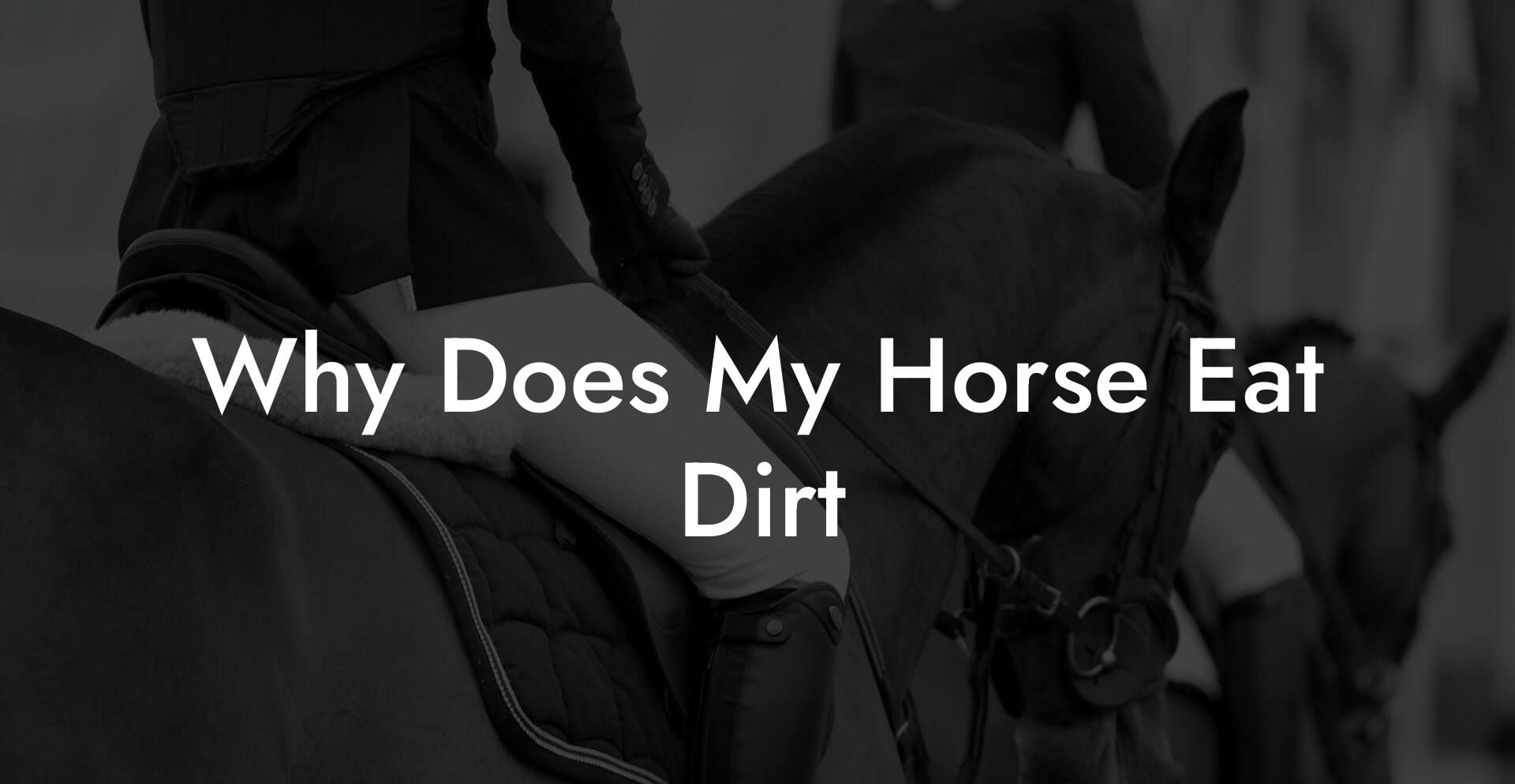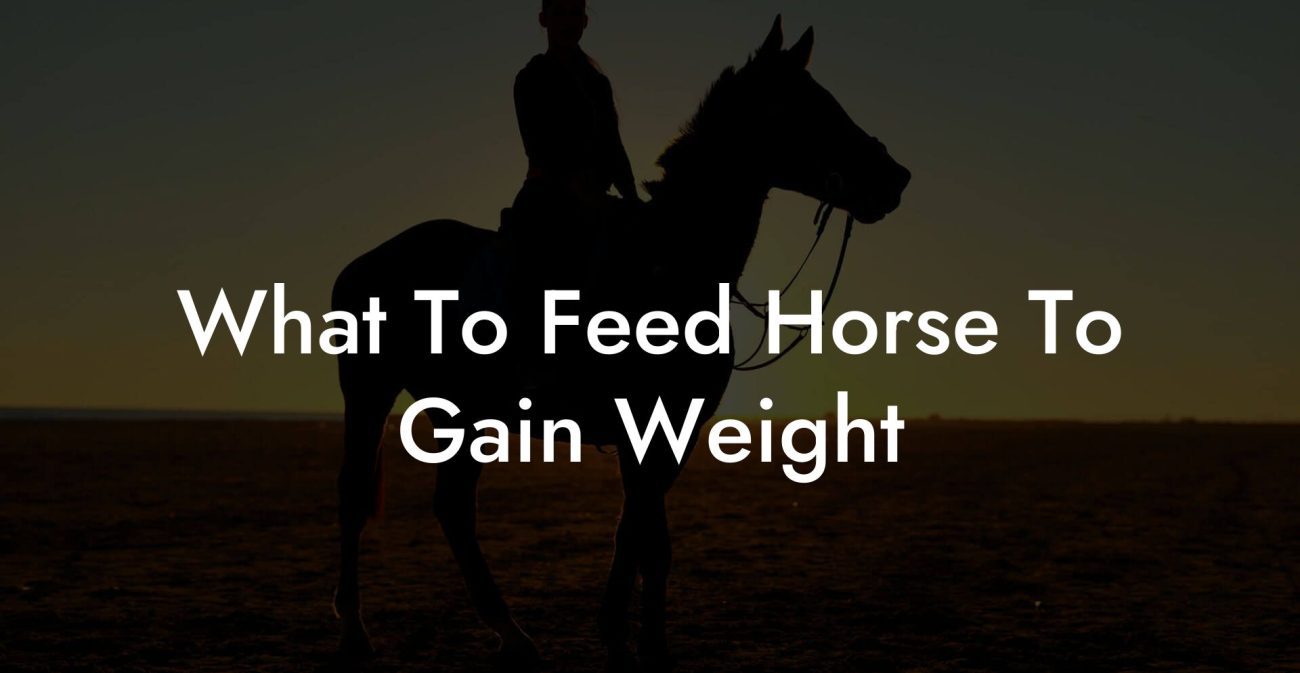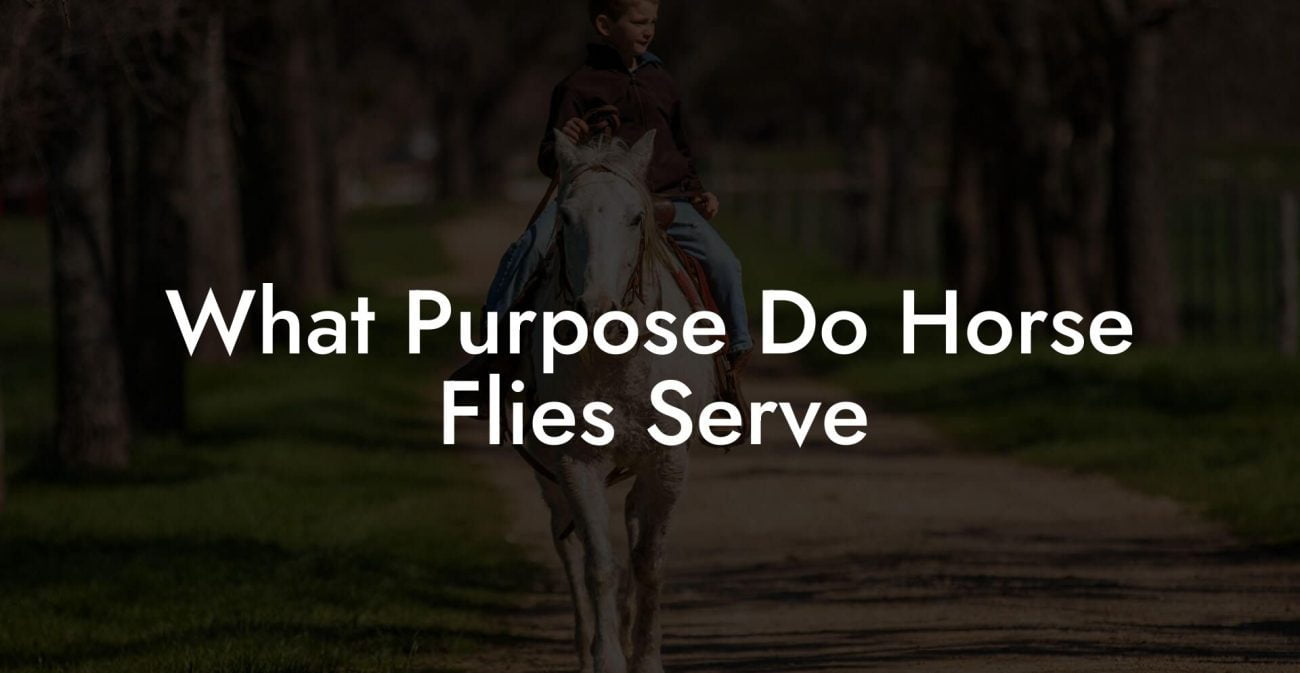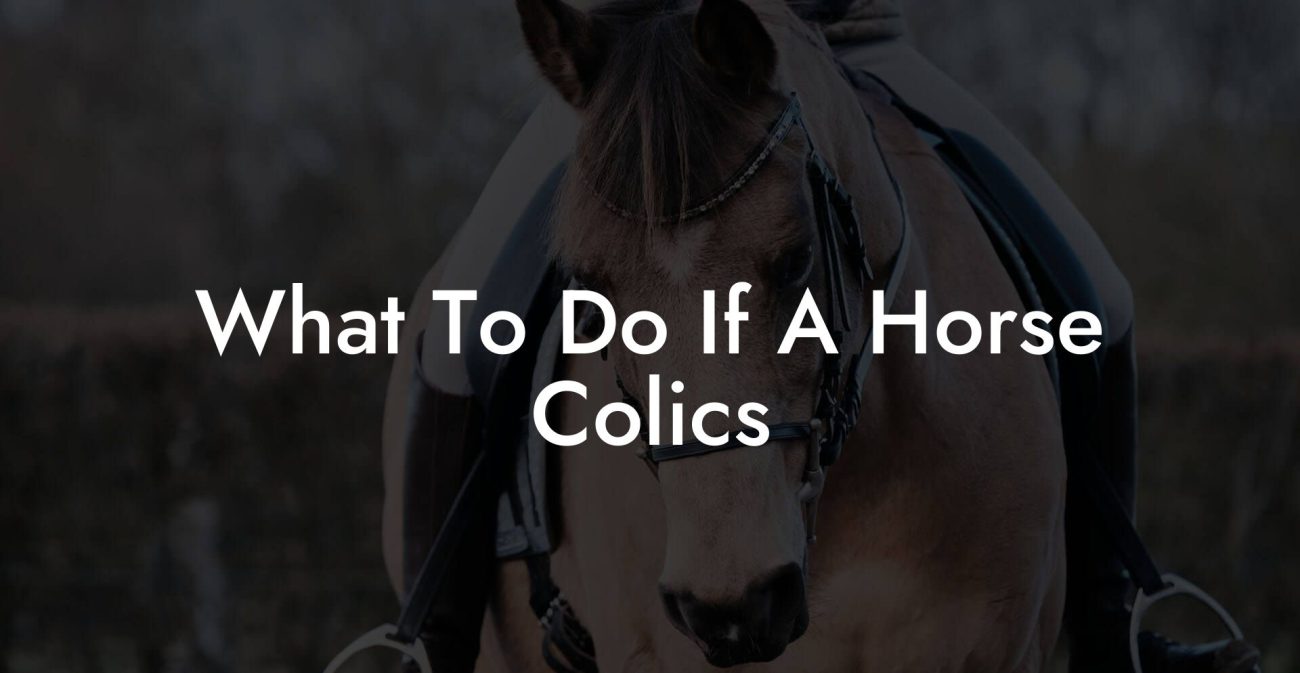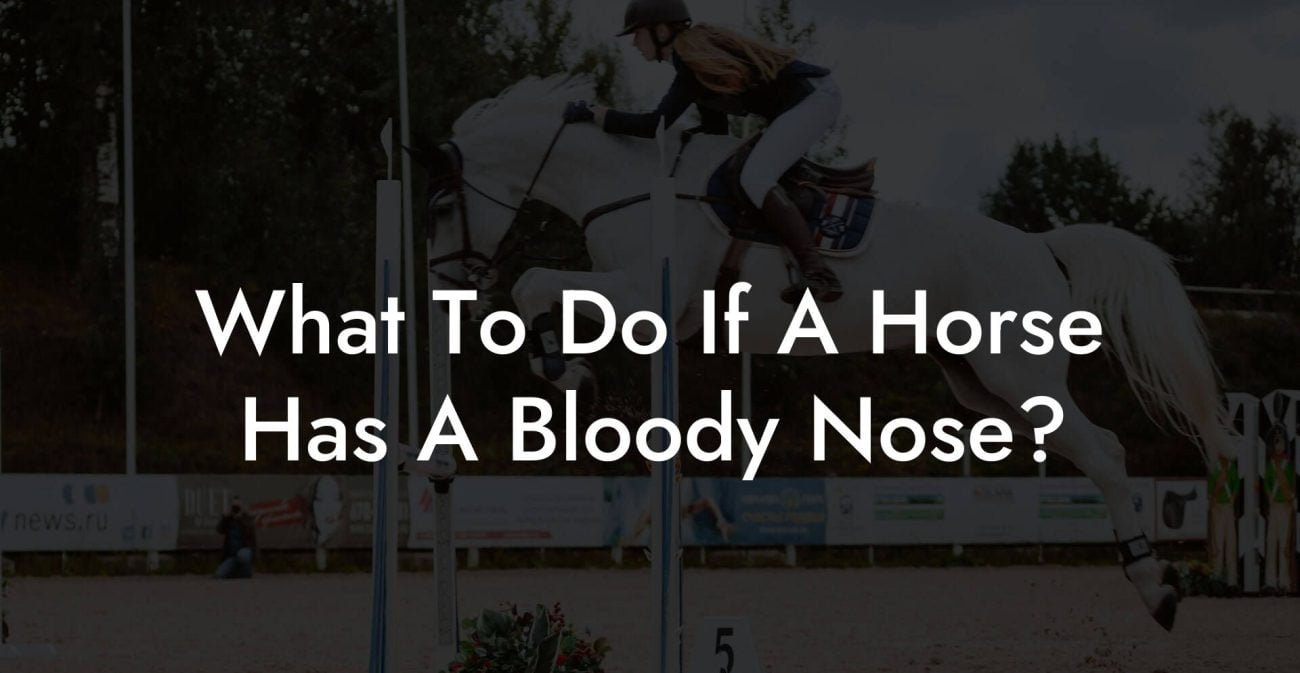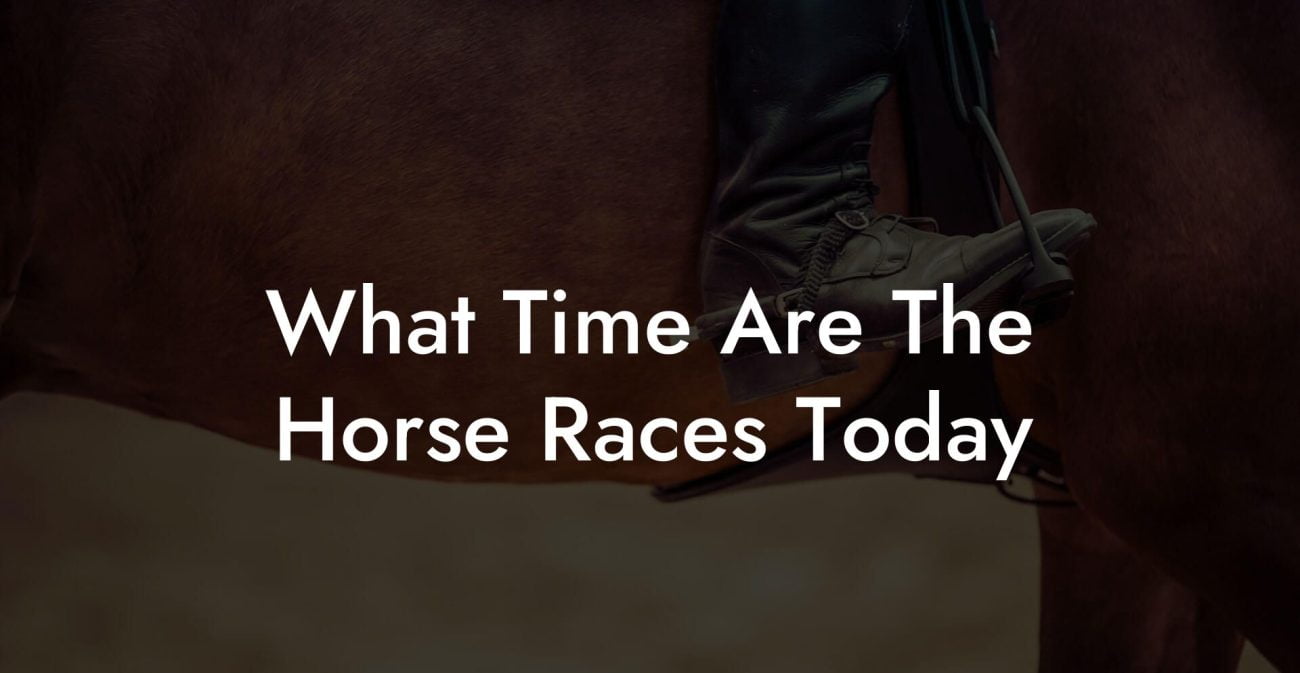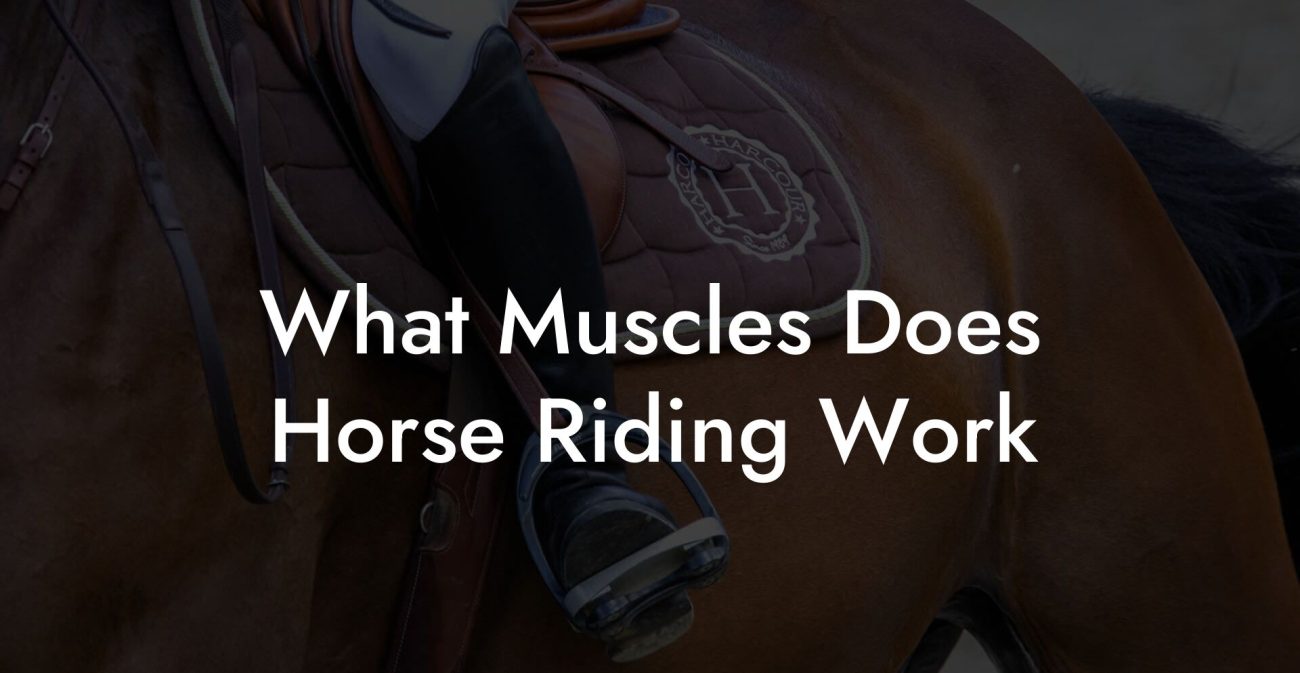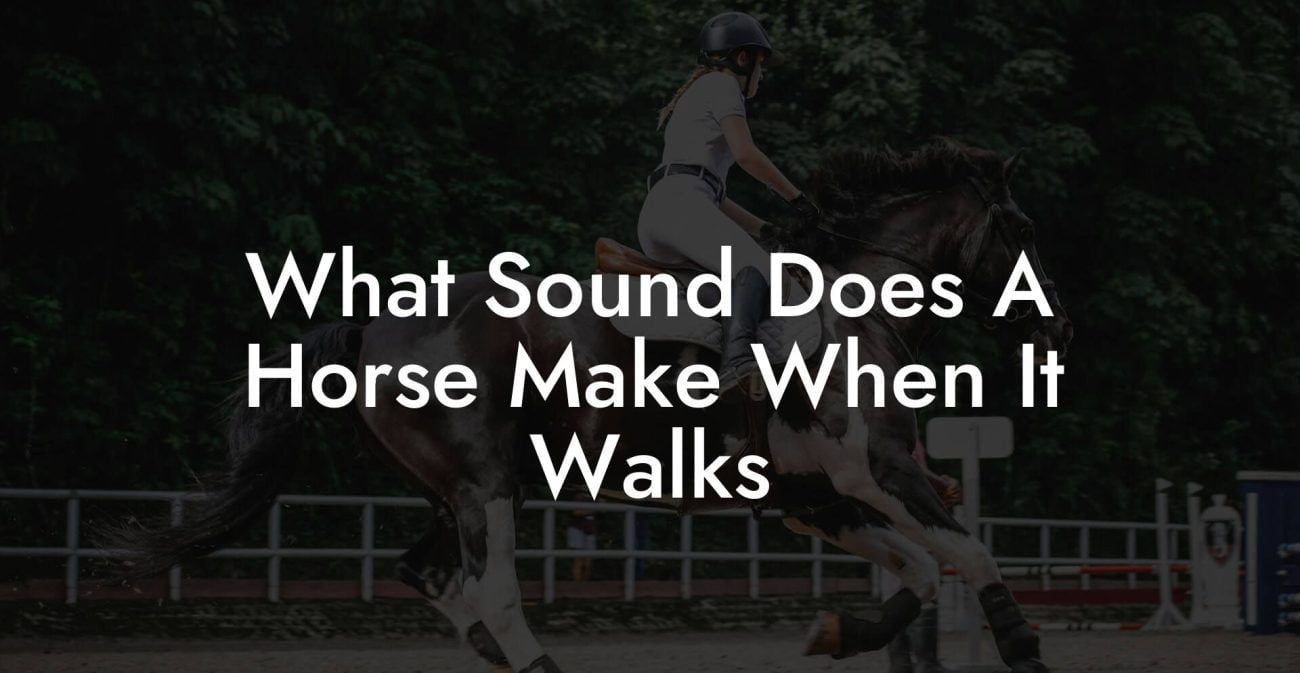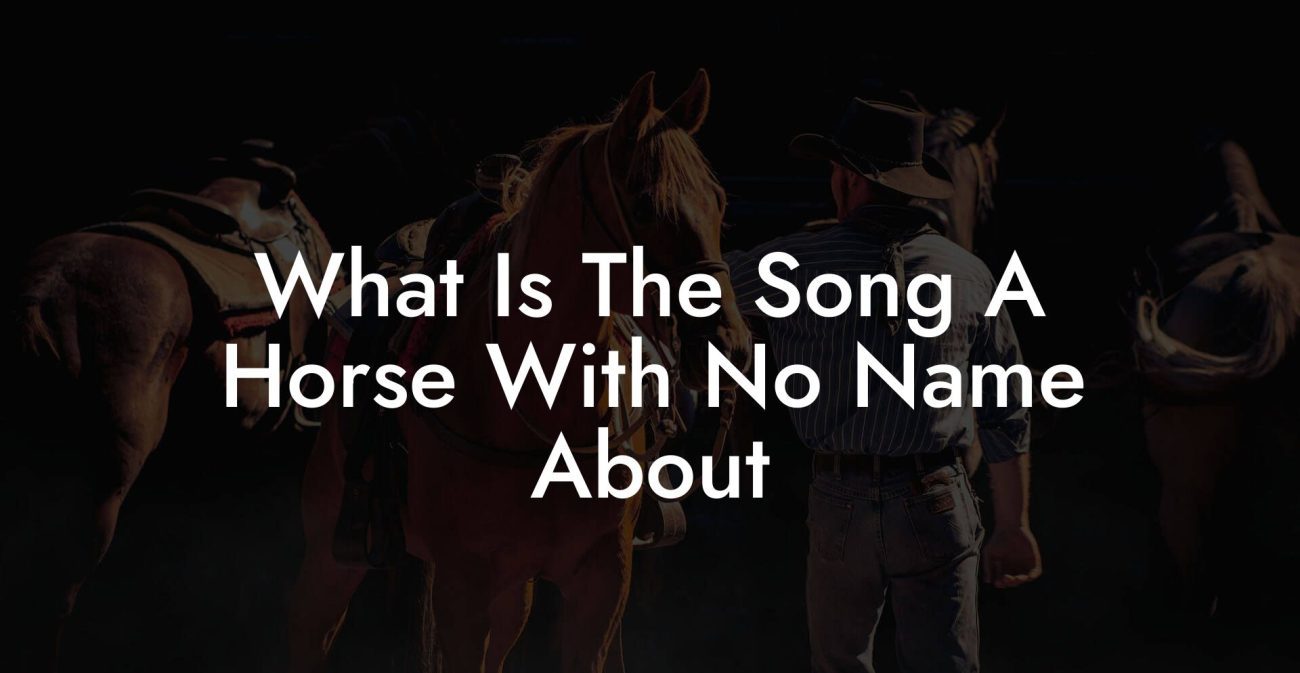Ever caught your horse digging through the dirt like it’s on a secret treasure hunt? You’re not alone, our equine pals sometimes get a little too curious about the earth under their hooves. Dirt-eating, or geophagia, might sound like an offbeat dining choice, but it’s a behavior that has puzzled both seasoned ranchers and millennial equestrians alike. Let’s dive into this quirky equine habit, exploring everything from potential nutritional needs and behavioral triggers to environmental influences, all while keeping it real and a bit humorous.
Quick Links to Useful Sections
- Unraveling the Dirt-Eating Mystery: Why Does My Horse Eat Dirt?
- Common Causes Behind Dirt-Eating in Horses
- Nutritional Deficiencies: When Minerals Are in Short Supply
- Digestive Discomfort and Natural Detoxification
- Behavioral Boredom and Environmental Enrichment
- Medical and Parasitic Issues
- Instinctual and Evolutionary Factors
- The Role of Diet in Dirt-Eating Behavior
- Quality Forage: The Foundation of Equine health
- Supplemental Minerals and Vitamins
- Balanced Diets: Forage, Concentrates, and Beyond
- Environmental Influences and Behavioral Enrichment
- Pasture Management: More Than Just Grass
- Stimulation Through Exercise and Play
- Social Dynamics and Herd Behavior
- Stress and Anxiety: The Unseen Triggers
- Medical Factors: When Dirt-Eating Signals a Deeper Issue
- Gastric Ulcers and Digestive Disorders
- Parasitic Infections
- Dental Issues and Chewing Behavior
- Preventative Measures and Practical Solutions
- Improve Nutritional Balance
- Enhance the Environment
- Regular Veterinary Checkups
- Implementing Stress Reduction Strategies
- Behavioral Modification Strategies: Re-Directing the Craving
- Increase Physical Activity
- Offer Tasty Alternatives
- Establish a Consistent Feeding Routine
- Positive Reinforcement Training
- Geophagia in the Equine World: A Look Beyond the Barn
- Wild Horses and Their Rituals
- Comparative Animal Behavior
- Studies and Research on Geophagia
- DIY Diagnostics: How to Monitor and Understand Your Horse’s Behavior
- Keep a Behavior Journal
- Use Technology to Your Advantage
- Consult with Specialists
- Resources and Community Support: Your Next Steps
- Online Forums and Social Media Groups
- Educational Websites and Blogs
- Local Equine Associations and Veterinary Professionals
- Workshops and Webinars
- The Future of Equine Health: Embracing Innovation and Tradition
- Emerging Trends in Equine Nutrition
- Technological Advances in Monitoring Behavior
- Sustainable Pasture Management
- Real-Life Stories: Transformative Journeys from Dirt to Delight
- Case Study 1: Discovering a Mineral Deficiency
- Case Study 2: Combatting Boredom with Enrichment
- Case Study 3: Early Intervention and Veterinary Care
- Your Personalized Action Plan: Steps to a Dirt-Free Life
- Step 1: Assess Your Horse’s Nutritional Intake
- Step 2: Evaluate the Environment
- Step 3: Monitor Behavior Diligently
- Step 4: Consult with Experts
- Step 5: Implement Changes and Observe Results
- Equine FAQs: Your Burning Questions Answered
- Your Journey to a Healthier, Happier Horse
Unraveling the Dirt-Eating Mystery: Why Does My Horse Eat Dirt?
When you see your horse saunter over to a patch of soil and start munching, it can feel as if your majestic companion has developed a taste for earthen snacks. But the truth is, there are several reasons behind this unconventional behavior, and they go way deeper than a case of “I’m just bored.”
The behavior, known in the animal world as geophagia, is not exclusive to horses, but in our equine friends, it raises some eyebrows, and rightly so! Whether it’s due to nutritional deficiencies, a way to soothe an upset stomach, or simply an instinctive quest for minerals, dirt-eating can be both a cry for help and a quirky habit. So buckle up as we dig (pun intended) into the world of dirt-eating horses!
Common Causes Behind Dirt-Eating in Horses
There isn’t one “aha!” moment that explains dirt-eating, it’s a multifaceted behavior resulting from a blend of nutritional, behavioral, and environmental factors. Let’s break it down:
Nutritional Deficiencies: When Minerals Are in Short Supply
One of the most straightforward explanations is that your horse might be lacking essential minerals such as sodium, iron, or zinc. Just like us, horses need a balanced diet to keep their systems humming. When key nutrients are missing, your horse might turn to the soil as an alternative source of these vital minerals.
If your horse’s diet falls short, whether due to poor quality forage or inadequate supplementation, it may lead to an instinctual “mineral hunt” where dirt becomes an attractive snack. Think of it as your horse’s way of filling nutritional gaps.
Digestive Discomfort and Natural Detoxification
Ever get that obnoxious bellyache that makes you crave bland toast? Horses can experience digestive distress too. In some cases, dirt-eating might help neutralize an overly acidic stomach or bind to toxins, facilitating their passage through the digestive tract. This self-medicating behavior is a natural detox response, though it’s not always the ideal remedy.
Behavioral Boredom and Environmental Enrichment
In today’s world, where our smartphones constantly demand our attention, boredom is a foe that affects all living beings, even horses. If a horse isn’t mentally stimulated or doesn’t have enough physical activity, it might develop cheeky habits like nibbling on dirt. Essentially, your horse could be saying, “Hey, I’m bored! Let’s mix things up a bit.”
Medical and Parasitic Issues
Sometimes, the reason behind dirt-eating lies in an underlying medical issue. Digestive disorders, gastric ulcers, or even parasitic infestations can push your horse towards dirt as a means to alleviate discomfort. If dirt-eating behavior is sudden or accompanied by other symptoms like weight loss or colic, it might be time to call the vet.
Instinctual and Evolutionary Factors
Believe it or not, dirt-eating has evolutionary roots. Wild horses and other grazing animals have been known to eat soil for millennia. The behavior might be linked to instinctual practices, either for obtaining minerals or aiding digestion. So, if your horse has this habit, it might be tapping into an ancient survival strategy.
The Role of Diet in Dirt-Eating Behavior
The saying “you are what you eat” rings true in the pasture. A well-balanced equine diet should offer all the essential nutrients, but what happens when it doesn’t? Let’s get into the nitty-gritty of equine nutrition and its correlation with dirt-eating.
Quality Forage: The Foundation of Equine health
Fresh pasture and high-quality hay are the cornerstones of a balanced diet. Horses thrive on fiber, which helps maintain digestive health. When forage quality declines or if the hay lacks key nutrients, your horse might be more inclined to seek out dirt for that extra mineral punch.
Supplemental Minerals and Vitamins
Mineral blocks and salt licks are designed to provide a dose of the minerals your horse might be missing. However, overreliance on these supplements, or using ones that don’t match your horse’s needs, can throw the natural balance off. It’s important to work with your vet or nutritionist to analyze your horse’s diet and determine if a tailored supplement is required.
Balanced Diets: Forage, Concentrates, and Beyond
Beyond forage and supplements, some horses may require a mix of concentrates to boost their caloric and nutritional intake, especially if they’re in heavy work or have special dietary needs. Introducing grains and pelleted feeds can help bridge nutritional gaps, but these should be introduced gradually and balanced with high-fiber content to avoid digestive issues.
Equine nutrition isn’t a one-size-fits-all affair. Consider your horse’s age, weight, workload, and overall health when designing a diet plan. What might work for a show jumper may not be ideal for a pasture pet whose main activity is browsing. Tailoring the diet can often be the key to warding off dirt-eating trends.
Environmental Influences and Behavioral Enrichment
A horse’s environment can play a huge role in its behavior. When horses aren’t given enough stimulation or space, they may engage in habits like dirt-eating simply out of boredom. Here, the focus is not just on physical nutrition, but on mental nourishment as well.
Pasture Management: More Than Just Grass
A well-managed pasture is like a five-star resort for horses. Mix up their grazing area to prevent monotony, and include natural obstacles or shaded areas to provide shelter and stimulation. Rotational grazing not only gives the soil a chance to recover but also offers a more diverse array of plants and textures, which can discourage a horse from fixating on dirt consumption.
Stimulation Through Exercise and Play
Modern horses, much like their human counterparts, need a healthy dose of exercise and fun. Activities such as trail riding, obstacle courses, and even group turnout sessions can help keep a horse’s mind engaged. The more a horse is active, the less likely it’ll turn to dirt-eating as a pastime.
Social Dynamics and Herd Behavior
Horses are social creatures. Their behavior often mirrors that of their companions. If one horse in the herd starts eating dirt, others might follow suit in a learned behavior or out of curiosity. Creating a balanced social environment with enough space and resources can reduce the tendency for such habits to proliferate.
Stress and Anxiety: The Unseen Triggers
Just like humans, horses can suffer from stress and anxiety, be it from sudden changes in routine, isolation, or even extreme weather. Stress can lead to various behaviors, including obsessive dirt eating. Recognizing and reducing stressors in your horse’s environment not only promotes overall well-being but could also reduce the urge to indulge in soil.
Medical Factors: When Dirt-Eating Signals a Deeper Issue
While dirt-eating is sometimes a natural response, it can also be a sign of underlying health problems. It’s important to know when to attribute the behavior to a benign habit versus when it signals a medical concern.
Gastric Ulcers and Digestive Disorders
Gastric ulcers are common in horses and can be incredibly painful. In some cases, the ingestion of dirt might be an instinctual way to neutralize stomach acid. If your horse displays other symptoms like weight loss, poor performance, or changes in behavior and appetite, it might be time to get a veterinary evaluation for digestive disorders.
Parasitic Infections
Internal parasites can wreak havoc on a horse’s digestive system. A parasite infestation may leave your horse feeling unwell and trigger unusual eating behaviors as it attempts to soothe gut discomfort. Regular deworming and fecal testing are essential parts of maintaining your horse’s health, and possibly curbing its dirt-eating tendencies.
Dental Issues and Chewing Behavior
Believe it or not, dental problems can also contribute to dirt-eating. When a horse experiences pain or discomfort due to dental issues, it may chew on non-food items, including dirt, as a misplaced attempt to alleviate the discomfort. Routine dental care can help prevent this and ensure your horse is comfortable while eating.
If dirt-eating behavior emerges suddenly or is accompanied by other worrying symptoms, such as lethargy, diarrhea, or changes in appetite, a thorough veterinary examination is crucial to rule out serious health problems.
Preventative Measures and Practical Solutions
Now that we know why your horse might be eating dirt, let’s talk about some proactive measures to help nip the behavior in the bud, while keeping your horse happy and healthy.
Improve Nutritional Balance
The first step is to examine your horse’s diet. Consult with an equine nutritionist to run a full analysis of your horse’s feed. Are there gaps in essential minerals? Might a high-quality salt lick or mineral supplement be the answer? Sometimes, simply tweaking their diet can drastically reduce the urge to supplement their nutrition with dirt.
Enhance the Environment
A stimulating environment can work wonders. Here are a few ideas:
- Rotational Grazing: Changing grazing areas periodically not only improves pasture quality but also reduces boredom.
- Interactive Toys and Enrichment: Jumping obstacles, treat dispensers, and even hay nets can keep your horse mentally engaged.
- Social Engagement: Ensure that your horse has robust interactions with other horses, facilitating natural behaviors that reduce stress.
Regular Veterinary Checkups
Consistent health monitoring is key. Regular vet visits can help detect early signs of digestive or dental issues, allowing you to address them before they lead to problematic behaviors like dirt-eating.
Implementing Stress Reduction Strategies
Stress can be a silent driver of strange behaviors. Consider integrating stress reduction techniques into your equine management routine:
- Provide Adequate Shelter: Ensure that your horse has access to shade and shelter during extreme weather conditions to minimize stress.
- Consistent Routine: Horses thrive on routine. Keeping feeding, turnout, and exercise schedules consistent can help reduce anxiety.
- Gentle Handling: A calm and patient approach during grooming or training reinforces trust and reduces overall stress.
Behavioral Modification Strategies: Re-Directing the Craving
While it might be tempting to chastise your horse for its eccentric snacking habits, it’s more fruitful to redirect its behavior with thoughtful modifications. Here are a few ideas to consider:
Increase Physical Activity
More exercise can translate to less boredom-driven dirt eating. Consider incorporating regular trail rides, turnout in larger fields, or even structured play sessions that challenge your horse both physically and mentally.
Offer Tasty Alternatives
If your horse is seeking something to nibble on because of dietary deficiencies, offering alternative treats that are safe and nutritious might satisfy its cravings. Experiment with molasses-coated treats or specially formulated chew blocks that provide essential minerals without the need for earth supplementation.
Establish a Consistent Feeding Routine
Creating a predictable routine can work wonders for behavior modification. When your horse knows exactly when to expect a balanced meal or treat, the urge to forage for extras may decrease.
Positive Reinforcement Training
Praise and rewards go a long way in altering behavior. Whenever your horse engages in desired actions, like eating its balanced feed instead of grazing on dirt, offer positive reinforcement. Over time, the behavior you want can eclipse the habit of dirt eating.
Geophagia in the Equine World: A Look Beyond the Barn
Dirt eating isn’t a phenomenon isolated to domestic horses. Across the globe, wild equines and other grazing animals have been observed engaging in geophagia. This behavior might stem from similar causes: mineral-seeking, digestive health, or even ritualistic practice.
Wild Horses and Their Rituals
In the wild, horses roam vast landscapes where mineral-rich soils are often more accessible than the sparse vegetation. Observing wild herds can reveal that dirt eating is more of a natural instinct rather than an anomaly. It’s an adaptive behavior that has been passed down through generations.
Comparative Animal Behavior
Other animals, from parrots to primates, engage in geophagia, underlining the cross-species relevance of this behavior. Understanding these parallels can provide insights into how evolution shapes dietary habits and might offer clues about managing this behavior in horses.
Studies and Research on Geophagia
Research on geophagia has shown that in many cases, animals consume dirt to rectify mineral imbalances. Recent studies have compared the soil composition of frequently visited grazing spots to horses’ nutritional needs, emphasizing the importance of a mineral-rich environment in maintaining equine health.
Scientists continue to investigate how environmental factors and diet interact to influence this behavior, offering practical insights that can be applied to horse management today.
DIY Diagnostics: How to Monitor and Understand Your Horse’s Behavior
Being a modern horse owner means you’re armed with technology and resources to monitor your horse’s behavior in real-time. Here are some practical steps to help you keep tabs on dirt-eating habits:
Keep a Behavior Journal
Documenting your observations is key. Note the frequency and conditions under which your horse eats dirt. Record relevant details like weather, feeding times, turnout duration, and any other behavioral patterns. Over time, trends may emerge that help you pinpoint triggers.
Use Technology to Your Advantage
Modern innovations in equine care include wearable devices that monitor activity levels, GPS trackers, and even apps for logging dietary intake. These tools can provide valuable data that reveal correlations between environmental settings and unusual behaviors like geophagia.
Consult with Specialists
Don’t hesitate to reach out to farriery, veterinary, or equine nutrition experts. Often, a multi-disciplinary approach is beneficial in addressing complex behaviors. A specialist’s insights might uncover factors you haven’t considered, from fodder quality to subtle health issues.
By diligently monitoring your horse’s habits, you not only ensure its well-being but also empower yourself to make informed decisions about its care.
Resources and Community Support: Your Next Steps
Navigating dirt-eating behavior can feel like a solo quest, but you’re part of a thriving community of equine enthusiasts and professionals who have been in your boots, or riding boots! Here’s how to tap into this vibrant network:
Online Forums and Social Media Groups
Platforms like Facebook groups, Reddit communities, and specialized equine forums are treasure troves of firsthand experience and advice. Connect with other horse owners who have dealt with geophagia and share strategies that worked wonders. Memes aside, these communities can offer invaluable insights and moral support.
Educational Websites and Blogs
There are countless blogs and websites dedicated to horse health and behavior. Follow reputable sources to stay updated on the latest research, nutritional advice, and innovative strategies to manage your horse’s unique quirks.
Local Equine Associations and Veterinary Professionals
Don’t underestimate the power of local expertise! Equine associations, riding clubs, and your local veterinarian can provide tailored guidance that considers your regional pasture conditions and weather. Their advice, backed by hands-on experience, might be just the supportive nudge your management plan needs.
Workshops and Webinars
Attend workshops or webinars focused on equine nutrition, behavior modification, and pasture management. Many of these events are geared toward modern horse enthusiasts, providing interactive sessions that blend scientific insight with fun, conversational tips.
Embrace these resources as stepping stones to a more harmonious and dirt-free pasture experience for your horse.
The Future of Equine Health: Embracing Innovation and Tradition
As we move further into the 21st century, the world of equine care is witnessing a blend of tradition and technology. New research, coupled with innovative monitoring tools and a deep appreciation for natural equine behavior, offers a promising path forward.
Emerging Trends in Equine Nutrition
Modern equine nutrition is moving toward personalized diets, using data and genomics to tailor feeding regimens to individual horses. This precision nutrition may well help minimize behaviors like dirt-eating by ensuring that every mineral and nutrient is balanced perfectly.
Technological Advances in Monitoring Behavior
From smart collars to real-time tracking apps, technology is revolutionizing the way we understand horse behavior. These tools provide actionable insights, allowing you to refine your horse’s care regimen and quickly address any deviations from normal behavior.
Sustainable Pasture Management
In a world increasingly conscious of sustainability, pasture management is being reimagined. Techniques such as rotational grazing, natural fertilization, and biodiversity enhancement not only improve soil quality but also contribute to reducing undesirable behaviors like dirt-eating.
Together, innovation and tradition are lighting the way to healthier, happier horses, and perhaps one day, eliminating the mystery of dirt-eating altogether.
Real-Life Stories: Transformative Journeys from Dirt to Delight
Sometimes the best way to understand a behavior is to see how others have overcome it. Here are a few stories from horse owners who transformed their horses’ lives by addressing the root causes of dirt-eating.
Case Study 1: Discovering a Mineral Deficiency
Sarah, a millennial horse owner, noticed that her once energetic gelding had begun scavenging the paddock for dirt. After consulting with an equine nutritionist, she discovered that his diet was low in sodium and magnesium. By adjusting his feed and incorporating a high-quality mineral block, Sarah not only curtailed the dirt-eating but also witnessed an overall improvement in his energy levels and coat shine.
Case Study 2: Combatting Boredom with Enrichment
Jake, a passionate equestrian blogger, realized that his mare’s newfound dirt-eating habit coincided with a long, uneventful turnout schedule. By introducing rotating pastures, interactive toys, and group turnout sessions, he transformed the paddock into a dynamic playground. The result? A busy, contented mare who was more interested in socializing and play than feasting on soil.
Case Study 3: Early Intervention and Veterinary Care
When Mark noticed his horse frequently digging into the earth and showing signs of discomfort, he immediately sought veterinary advice. The vet diagnosed a mild case of gastric irritation and recommended dietary changes along with stress reduction techniques. Mark’s quick response not only resolved the dirt-eating issue but also enhanced his horse’s overall digestive health.
These stories serve as powerful reminders that with the right blend of nutrition, environmental enrichment, and supportive care, even the quirkiest habits can be managed, often turning a potential problem into a stepping stone for improved health.
Your Personalized Action Plan: Steps to a Dirt-Free Life
Ready to tackle the dirt-eating dilemma once and for all? Here’s a step-by-step guide to help you create a personalized action plan tailored to your horse’s unique needs.
Step 1: Assess Your Horse’s Nutritional Intake
Start by analyzing your horse’s current diet. Consult with an equine nutritionist and consider running feed analysis tests to determine if there’s a mineral deficit. Keep a log of what, when, and how much your horse eats. This detailed record is the first step in addressing potential nutritional gaps.
Step 2: Evaluate the Environment
Look around your paddock, is it engaging, or is it just a monotonous patch of dirt? Examine your pasture management practices. Rotational grazing, the addition of enrichment items, and ensuring proper shelter and shade are all pivotal in creating an environment that minimizes boredom.
Step 3: Monitor Behavior Diligently
Keep a detailed journal of your horse’s behavior. Note the times and circumstances under which it eats dirt. Pair this observation with technological tools such as tracking devices and behavior monitoring apps. A comprehensive log will help you correlate events and pinpoint triggers.
Step 4: Consult with Experts
Don’t hesitate to seek advice from veterinarians, equine nutritionists, and behavior specialists. Their insights may reveal underlying issues that aren’t immediately obvious. A professional evaluation is often the key to a swift resolution.
Step 5: Implement Changes and Observe Results
Once you’ve identified potential deficiencies or environmental causes, implement targeted changes, whether that’s dietary adjustments, supplemental minerals, or enriching the paddock. Commit to a trial period and closely monitor for improvements. Remember, consistency is key.
With careful observation and a willingness to adjust, you can significantly reduce, and eventually eliminate, the dirt-eating behavior. Your horse will thank you with a healthier digestive system and a happier disposition.
Equine FAQs: Your Burning Questions Answered
Here are some frequently asked questions regarding dirt-eating in horses, designed to provide quick answers to common concerns:
1. Is it normal for horses to eat dirt?
While not every horse eats dirt, it’s a relatively common behavior known as geophagia. It may be linked to nutritional deficiencies, digestive issues, stress, or boredom.
2. How can I tell if my horse’s dirt-eating is due to a mineral deficiency?
A mineral deficiency can be suspected if your horse’s diet lacks essential nutrients like sodium, zinc, or magnesium. A feed analysis and consultation with an equine nutritionist can provide clarity.
3. Could dirt-eating harm my horse?
In many cases, dirt-eating is a natural behavior. However, excessive consumption can lead to digestive blockages or the ingestion of harmful contaminants. Monitoring and addressing the root cause is crucial.
4. What are some quick fixes to stop dirt-eating temporarily?
Ensuring your horse has access to a high-quality salt lick or mineral supplement can sometimes curb the behavior. Additionally, providing interactive toys or more turnout time may help distract your horse.
5. When should I consult a veterinarian about dirt-eating?
If you notice a sudden increase in dirt-eating behavior, especially when accompanied by other symptoms like weight loss, colic, or changes in behavior, it’s vital to consult a vet immediately.
6. Can environmental enrichment alone stop my horse from eating dirt?
Environmental enrichment can significantly reduce boredom-related dirt-eating. However, if the root cause is a nutritional deficiency or a medical issue, additional interventions may be necessary.
7. Is dirt-eating an instinctual behavior for horses?
Yes, geophagia has evolutionary roots. Wild and domesticated horses alike may resort to dirt consumption as an instinctual response to dietary needs or digestive discomfort.
8. What role do stress and boredom play in this behavior?
Stress and boredom are significant contributing factors. A lack of mental stimulation or environmental variation can lead horses to engage in non-nutritive behaviors like dirt-eating.
9. Can altering my horse’s diet reduce its dirt-eating behavior?
Absolutely. By enhancing the nutritional content of your horse’s diet, especially its mineral content, you can often curb the urge to seek out dirt.
10. How long does it typically take to see an improvement after making dietary or environmental changes?
It varies from horse to horse. Some may show improvements within a few weeks, while others could take a few months. Patience and consistency are key.
Your Journey to a Healthier, Happier Horse
Tackling the mystery of why your horse eats dirt can seem overwhelming at first, but with careful observation, adjustments to diet and environment, and a healthy dose of patience (and humor), you can significantly improve your horse’s well-being. Every horse is unique, and its journey toward better health is as individual as its personality.
By understanding the intricate balance between nutrition, behavior, and environment, you’re not just solving a quirky habit, you’re paving the way for a robust, energetic, and happier equine companion. Engage with your horse’s world, ask the tough questions, and don’t be afraid to experiment with new strategies. Often, the key to success lies in a blend of traditional wisdom and modern innovation.
Your journey to nurturing a healthier, dirt-free lifestyle for your horse starts with small changes, each observation, each tweak to the diet, every enhanced turnout experience, is a step toward a more balanced life. Embrace the challenge with a smile, knowing that every step you take enriches the bond between you and your magnificent four-legged friend.
So saddle up, dive deep, and explore the many facets of equine care, from the science of nutrition and the art of pasture management to the understanding of natural behaviors. The path ahead is as exciting as it is rewarding, promising a future where both you and your horse thrive in harmony. Your quest for equine excellence begins here, dig in (pun intended) and enjoy every moment of this adventure!

